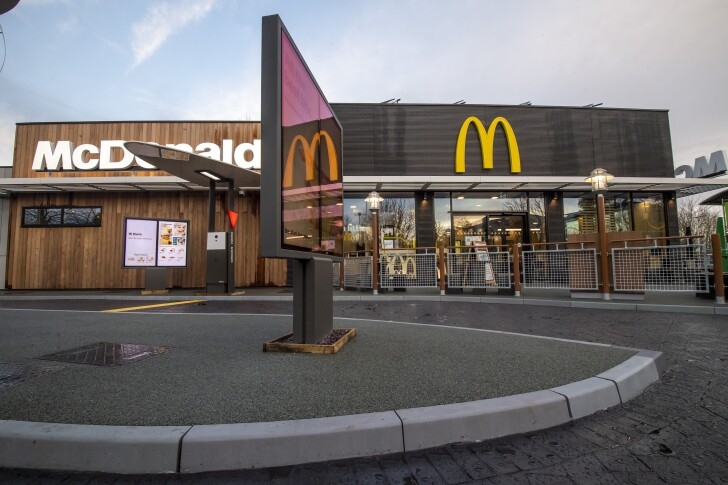McDonald's has opened what it calls the UK's first net-zero carbon restaurant dubbed “The Market Drayton McDonald’s”, which will serve as a blueprint for future restaurants around the country.
The Market Drayton McDonald’ has been designed to be a net-zero emissions standard in both construction and everyday operation.
The restaurant is built to the UK Green Building Council's net-zero standard, which is among the first to account for embodied carbon, which is the upfront carbon emitted during the restaurant’s construction.
McDonald's reduced the upfront carbon emissions by replacing the usual concrete piles with a concrete slab made using pulverized fuel ash and blast-furnace slag to reduce portland cement content. McDonald's development director Gareth Hudson emphasized that the building frame itself was steel.
Lowering the carbon footprint of the modular steel frames for the structure of the building was more challenging. McDonald’s worked with supplier Elliott and with a specialist company called Recycled Steel.
As there is not enough recycled steel in the market to meet demands, McDonald’s opted for low-carbon European steel, which is a mixture of new and recycled steel. “
The walls were wrapped in sheep wool and covered in metal developed from recycled IT equipment and "white goods" such as washers, refrigerators, stoves, and cookers, along with sustainably harvested poplar and plastic cladding made from recycled plastic bottles. The internal parapets on the roof, which no one sees, are presumably constructed of recycled toasters and blenders.
Instead of using aluminum commercial windows, it has used sustainably sourced timber.
A thousand concrete curbs were replaced with Durakerbs made from recycled bottles, and the drive-thru lane is paved with recycled tires. McDonald's claims that "this material releases less carbon dioxide and allows greater water absorption, lowering rainwater drainage."



 How your festival wee could disrupt soil health and water quality
How your festival wee could disrupt soil health and water quality  ‘It’s time to give up on normal’: what winter’s weird weather means for the warm months ahead
‘It’s time to give up on normal’: what winter’s weird weather means for the warm months ahead  As Colombia hosts a UN biodiversity summit, its own Amazonian rainforest is in crisis
As Colombia hosts a UN biodiversity summit, its own Amazonian rainforest is in crisis  ‘Humanity is failing’: official report warns our chance to save the Great Barrier Reef is fast closing
‘Humanity is failing’: official report warns our chance to save the Great Barrier Reef is fast closing  Humanity needs more rare earth elements. Extinct volcanoes could be a rich new source
Humanity needs more rare earth elements. Extinct volcanoes could be a rich new source  The skyscraper-sized tsunami that vibrated through the entire planet and no one saw
The skyscraper-sized tsunami that vibrated through the entire planet and no one saw  Wall Street Plummets as Powell Cautions on Rate Cuts and Trump Cabinet Picks Shake Confidence
Wall Street Plummets as Powell Cautions on Rate Cuts and Trump Cabinet Picks Shake Confidence  화산으로 전기 생산 가능할까?
화산으로 전기 생산 가능할까?  Russia Cuts Gas to Austria in Payment Showdown: EU Energy Crisis Takes a Heated Turn
Russia Cuts Gas to Austria in Payment Showdown: EU Energy Crisis Takes a Heated Turn  Tech Stocks Surge in Asia; Experts Warn ‘Cooling AI Boom May Hit NVIDIA’s Gains Hard’
Tech Stocks Surge in Asia; Experts Warn ‘Cooling AI Boom May Hit NVIDIA’s Gains Hard’  Why Inflation Won’t Stop Tariffs: ‘The Political Agenda Matters More,’ Warns Economist
Why Inflation Won’t Stop Tariffs: ‘The Political Agenda Matters More,’ Warns Economist  Prime time for cicadas: what a once-in-1,547-year bug population surge tells us about the nature of reality
Prime time for cicadas: what a once-in-1,547-year bug population surge tells us about the nature of reality  Tesla’s 5% Surge Sends S&P 500 Soaring Amid Tech Rally: 'Self-Driving Revolution On The Horizon'
Tesla’s 5% Surge Sends S&P 500 Soaring Amid Tech Rally: 'Self-Driving Revolution On The Horizon'  Healthy soils are good for your gut, brain and wellbeing – here’s why
Healthy soils are good for your gut, brain and wellbeing – here’s why 































